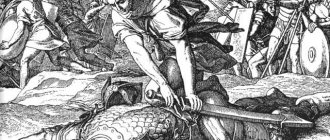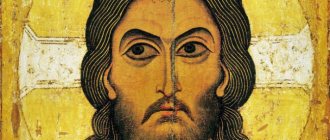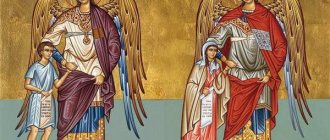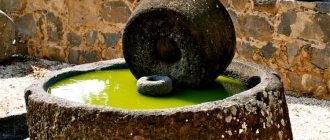> All books >
“Christadelphians. What they believe and what they preach.” Harry Tennant
| Introduction | 6. Who is the king? | 12. The Word made flesh | Appendix 2 "Fallen Angels" and Satan | 22. Walking with God |
| 1. Our land | 7. Who will be king? | 13. Priest forever and ever | 17. Demons (demons) | 23. The student and the world |
| 2. Man: good or bad? | 8. What will the Kingdom of God be like? | 14. Holy Spirit | 18. Angels | 24. Communication Bread and wine |
| 3. Death: friend or foe | 9. How can this happen? | Appendix 1 Gifts of the Holy Spirit | 19. Resurrection and judgment | 25. The mystery of Israel |
| 4. The Beginning of God's Promises | 10. The Lord who redeemed me | 15. World of Evil | 20. Repentance and conversion | 26. Signs of the Return of Christ |
| 5. God's covenant with Abraham | 11. Christ: whose son is He? | 16. Jesus and the Devil | 21. Why shouldn't I be baptized? | 27. Goodbye |
The Bible reveals much more about the Lord Jesus than we have seen so far. It is good that we seek deeper knowledge of Him, for in Him “are hidden all the treasures of wisdom and knowledge” (Colossians 2:3).
Of all the aspects of Christ that believers have pondered over the centuries, the most intriguing to them was the sonship of the Savior. As strange as it may seem to others, there are believers who are content to see Jesus as the true son of Joseph, the husband of Mary. Such people disregard the testimony of the virgin birth and generally believe that the divine sonship of Jesus flows only from His character and not from His exclusive descent.
On the other spectrum of all kinds of beliefs is the idea that Jesus was and is eternally the Son of God, who received flesh in the womb of a virgin. This teaching came to light only after theological debate over the centuries, and now forms one of the fundamental creeds of the Orthodox churches. For those who believe this, this doctrine is of exceptional value.
What should a seeker of truth do under such circumstances? How can he get to her? Above all else, he must approach this subject with the deepest humility and reverence. We are on holy ground. We are not involved here in mere speculation or academic debate, the results of which may help us develop our intellect or achieve the logical satisfaction of solving a spiritual equation. We must not forget that we - transitory creatures from the dust - seek the knowledge of Almighty God and Him of whom it is said that He is His beloved Son. So let's approach our subject with due respect (at least) and awe.
We must first have a firm foundation that everything we know about the Lord Jesus Christ comes from the Bible. There should be no other basis for our similarity to the subject. Everything that has been written so far by people and accepted by churches would never have seen the light of day without the main source of revelation and knowledge - the Word of God in our hands. Therefore, any concept or discovery that goes beyond what this word reveals to us or that contradicts It should immediately seriously alert our minds. It is quite obvious that to contradict the Word of God means to use some other authorities, some other arbiters in matters of faith and practice. Moreover, we put our faith and hope in mortal danger if we question the very book of the gospel of salvation.
Immaculate Conception
The belief that Jesus was the son of Joseph, although very old, cannot be sustained in one form or another without denying the simple and clear account of the conception and birth of Jesus as given in the Gospels of Matthew and Luke. They provide no basis for this denial. It cannot be proven that the texts of these two Gospels were altered by later additions to those parts that tell about the virgin birth. The texts have a deep foundation and are in any case supported by numerous references to them from other parts of Scripture. Therefore, any assumption of Joseph's theory must come from some other source, which may be a direct challenge to the authority of Scripture.
Firmly believing the Bible to be the fully inspired and infallible reproduction of God's revelation to man, Christadelphians cannot tolerate any other view that casts doubt on its crystal clear teaching.
The biblical reference to the Fatherhood of God in relation to Jesus is very clear throughout the Bible:
“I will be a Father to him, and he will be My son” (2 Samuel 7:14).
“He will call upon Me: You are my father, my God, and the rock of my salvation” (Psalm 89:27).
“An angel of the Lord appeared to him in a dream and said: Joseph, son of David! Do not be afraid to accept Mary, Your wife; For whatever is born in her is of the Holy Spirit” (Matthew 1:20).
“And the Angel said to Her: Do not be afraid, Mary, for You have found favor with God; and behold, you will conceive in your womb and give birth to a Son, and you will call His name Jesus; He will be great and will be called the Son of the Most High... The Holy Spirit will come upon You, and the power of the Most High will overshadow You; therefore the Holy One who is to be born will be called the Son of God” (Luke 1:30-35).
“And the Word became flesh and dwelt among us, full of grace and truth; and we have seen His glory, the glory as of the only begotten from the Father” (John 1:14).
“For God so loved the world that he gave his only begotten Son, that whoever believes in him should not perish but have eternal life” (John 3:16).
“For to which of the Angels did God ever say: “You are My Son, today I have begotten You?” And again: “I will be His Father, and He will be My Son?” (Hebrews 1:5).
“Blessed be the God and Father of our Lord Jesus Christ” (1 Peter 1:3).
“But when the fullness of the time was come, God sent forth his only begotten Son, who was born of a woman” (Galatians 4:4).
“Therefore the Lord Himself will give you a sign: behold, a virgin will conceive and give birth to a Son, and they will call His name Immanuel” (Isaiah 7:14; Matthew 1:23).
From these quotations of Scripture there can be no doubt that God was the Father of the Lord Jesus Christ in a unique manner, quite different from the Fatherhood of God common among believers. The expressions “His only begotten Son,” “Son of the Most High,” “Only Begotten of the Father,” and “Son of God” indicate quite clearly the exceptional circumstances surrounding the conception and birth of the Lord Jesus.
Believing the Bible, we must therefore believe that Jesus was the true Son of God without any earthly father.
Only when we consider the connection between the conception of Jesus and His birth will we come to understand the statements made to this effect in the teachings of the churches. They declared that Jesus was begotten from eternity and was the eternal Son of God. He always existed and was, according to these views, the true Son of God. Let's look at some of the expressions in which people express this doctrine:
At the Council of Nicaea, held in 323 AD, the following creed was adopted:
“I believe in one God, the Father Almighty, Creator of heaven and earth, visible and invisible, in one Lord Jesus Christ, the Only Begotten Son of God, who was born of the Father before all ages, and by Him all things were, light from light, true God and true God, begotten, uncreated, consubstantial with the Father, by whom all things were created, in heaven and on earth; for our sake, man and for our salvation, who came down from heaven and became incarnate of the Holy Spirit and the Virgin Mary and became human, was crucified for us under Pontius Pilate and suffered and was buried and rose again on the third day according to the Scriptures and entered into heaven, and sits at the right hand of the Father and again the one who comes judge the living and the dead with glory..."
In Athanasius the Great (293-373) we read:
“We believe in One God in three hypostases and in the Trinity as Unity: without mixing them, without dividing their essence. There is one hypostasis of the Father, another of the Son and a third of the Holy Spirit, but the Divinity of the Father and the Son and the Holy Spirit is one... The Son is God... the only begotten Son of the Father: not created, but begotten.”
The first 39 Articles of the Church of England read:
“The Son, who is the Word of the Father, is begotten of the eternal Father. The true and eternal God, consubstantial with the Father, who received human nature in the womb of the good Virgin from her essence and thus absorbed two whole and perfect natures, that is, the Divine essence and the Human essence, which were united together in one person, never divided, of which Christ true God is true man."
For many sincere believers, these statements contain the essence of truth about the Son of God and provide them with real comfort in a troubled and fickle world. We all deeply respect the feelings of believers of other faiths and expect the same from them. We therefore politely invite them to look at the feelings and beliefs of Christadelphians regarding this central aspect of the faith and to trace how we have arrived at our position and views, which to us are fundamental truth and hence invaluable.
The language of the creeds we have given is exquisitely chosen and unforgettable. It's a mixture of phrases taken from the Scriptures and phrases you won't find there. For example, the terms “the first-born age,” “two whole and perfect natures,” and “the trinity as a unity” are not contained in Scripture. They are human descriptions of what their authors believe is true. For this reason, we must compare them with what the Bible teaches. What will we find then?
Jesus Christ
God's Son. The Messiah, who became an atoning sacrifice for the sins of people. The founder of one of the world's greatest religions - Christianity. The central character of the Christian religious-mythological and dogmatic system and the object of Christian religious cult.
Jesus Christ was born in the 1st century BC. in the city of Bethlehem, Palestine. His mother, the Virgin Mary, took a vow of eternal virginity, and when she came of age, she was married to the pious elder Joseph of Nazareth, who had great respect for the vow.
Soon the Archangel Gabriel appeared to the Most Pure Virgin and brought the good news that she was to have a son, conceived through the Holy Spirit, and named the exact date. And indeed, Maria soon realized that she was pregnant. The woman did not yet realize the role that her son had to play, but she understood that she had become a participant in a real miracle of the immaculate conception.
Joseph, who returned home after some time, immediately noticed the changes that had occurred in his wife. This kind man did not immediately believe Maria’s story, deciding that the naive girl had simply become a victim of deception by some neighbor’s young man who had seduced her.
The old man did not blame his wife and even wanted to secretly allow her to leave the city so that she would not become a victim of justice: treason in those days was severely punished, an unfaithful woman could be stoned and whipped. Then an angel appeared to the carpenter, telling him about the immaculate conception of Mary. This convinced Joseph of his wife’s innocence, and he allowed the girl to stay.
Shortly before the due date, Caesar Augustus announced a general population census. To do this, people had to come to Bethlehem on their own. Joseph and Mary set off on their journey. Arriving at the place, we found that the city was simply overcrowded with crowds of people. It was not possible to find a place to stay for the night, and the couple decided to spend the night in a cave in which the shepherds hid their cattle from the rains.
That night the prediction was fulfilled, and the Blessed Virgin Mary gave birth to a baby. The boy's first cradle was a manger for feeding animals. The first to learn about the birth of the Messiah were the Bethlehem shepherds, who tended their flocks at night. Suddenly everything lit up with light, an Angel appeared before them and announced the birth of the Savior.
Meanwhile, the Magi came to Jerusalem from the East. The sages traveled a long way to worship the newborn Savior, the coming king of the Jews. His birth was marked by the appearance of a bright star in the sky, showing the way to the sages. Following the Christmas star, the wise men went to Bethlehem. The star stopped over the roof of the house into which Mary and the baby and Joseph, having left the cave, settled. Seeing the newborn Savior, they knelt down and presented their gifts: gold, incense and myrrh.
On the eighth day from birth, the baby was circumcised and given the name Jesus, as the Angel called Him before conception in the womb. On the fortieth day, he was brought by his parents to the Jerusalem Temple to perform the ritual of sacrificing two turtle doves. An old man named Simeon came out, met Mary and Joseph with Jesus and said blessings.
While the Holy Virgin Mary was in Bethlehem with her husband and newborn baby, the cruel and ambitious King Herod learned about the birth of the Son of God. However, the predictors who told about the miracle that happened could not answer the question into whose family Jesus was born.
Then, without hesitation, the king ordered the destruction of all the newborns that were in Bethlehem. Joseph was warned about the impending trouble by an angel who again appeared to the elder in a dream. Then the carpenter took refuge in Egypt with Mary and the baby, and only when the danger had passed did he return with his family to his native Nazareth.
When Jesus grew up, he began to help his betrothed father in carpentry, which is how he later earned his living. At the age of twelve, he came with his parents to Jerusalem for Easter, where for four days he had spiritual conversations with scribes who interpreted the Holy Scriptures. The boy amazed his mentors with his knowledge of the Laws of Moses, and his questions puzzled more than one teacher.
Until the age of thirty, Jesus lived with his parents and helped them in every possible way, and after that an insight descended on him. Christ strongly desired to become a preacher, telling people about divine phenomena and the meaning of religion. Therefore, he went to the Jordan River, where he was baptized by John the Baptist.
After his baptism, Jesus Christ, led by the Spirit, withdrew into the desert in order to prepare in solitude, prayer and fasting to fulfill the mission with which he came to earth. At this time, Satan tried to hinder him through temptations, which became more sophisticated each time. Having endured everything, he began his preaching and public service.
Jesus preached a sermon about repentance in the face of the coming of the Kingdom of God. He began to teach that the Son of God would suffer cruelly and die on the cross, and that His sacrifice was the food that everyone needed for eternal life. In addition, Christ confirmed and expanded the law of Moses: according to the commandment, first of all, with all your being, love God and your neighbors as yourself. At the same time, do not love the world and everything in the world and “do not be afraid of those who kill the body, but cannot kill the soul.”
Despite the fact that the center of Christ's preaching was the holy city of Jerusalem, he traveled for the longest time with his preaching in Galilee, where He was received more joyfully. Jesus also passed through Samaria, the Decapolis, and was within the boundaries of Tire and Sidon.
Many followers gathered around Christ, from whom he first chose twelve closest disciples - the apostles, then others less close, who are also called apostles, some of them, however, soon left him.
Jesus supported his teaching with various miracles and is glorified as a prophet and healer of incurable diseases. He raised the dead, tamed the storm, turned water into wine, fed five thousand people with five loaves, and much more. I visited Jerusalem four times for the annual celebration of Easter.
The more Jesus won people's love, the more the nobles of Jerusalem hated him. The nobles were afraid that their power would be shaken and conspired to kill the messenger of God. Christ triumphantly rode into Jerusalem on a donkey, thereby reproducing the Jewish legend about the triumphant coming of the Messiah.
The people enthusiastically greeted the New Tsar, throwing palm branches and their own clothes at his feet. People expected that the age of tyranny and humiliation would soon end. With such pandemonium, the Pharisees were afraid to arrest Christ and took a wait-and-see attitude.
The Jews expected from Him victory over evil, peace, security and stability, but Jesus, on the contrary, invited them to renounce everything worldly and become homeless wanderers who would preach the word of God. Realizing that nothing would change in power, people hated God and considered God a deceiver who had destroyed their dreams and hopes. The Pharisees also played an important role here, inciting a rebellion against the “false prophet.”
According to the Gospel, the passion of Christ is usually called the torment endured by Jesus in the last days of his earthly life. Among them is the Supper in Bethany, when the sinner washed Christ’s feet with myrrh and her own tears, and wiped them with her hair. Then came the washing of the feet of his disciples by the son of God. When He and the apostles came to the house where it was necessary to eat Passover, there were no servants to wash the guests’ feet. Then Jesus himself washed the feet of his disciples, thereby teaching them a lesson in humility.
At the Last Supper, Christ predicted that his disciples would abandon him and betray him. Soon after this conversation, Judas left the supper. Then, at the Mount of Olives, he cried out to the Creator and asked for deliverance from his impending fate, but received no answer. In deep sadness, Jesus went to say goodbye to his disciples, expecting earthly torment.
Descending from the mountain in the dead of night, Jesus informed them that the traitor was already close and asked his followers not to leave. However, at the moment when Judas arrived with a crowd of Roman soldiers, all the apostles were already fast asleep. The traitor kissed Christ, supposedly greeting him, but thereby showed the guards a true prophet. And they put Him in shackles and took Him to the Sanhedrin to administer justice.
The Jewish high priests, having condemned Christ to death at the Sanhedrin, could not themselves carry out the sentence without the approval of the Roman governor. After unsuccessful attempts to accuse him of a formal violation of Jewish law, Jesus was handed over to the Roman procurator of Judea, Pontius Pilate.
Pilate, finding no guilt in Jesus, was inclined to let him go and said to the chief priests: “I find no guilt in this man.” The decision caused an uproar among the Jewish crowd, directed by the elders and chief priests. Trying to prevent unrest, the procurator addressed the crowd with a proposal to release Christ, following the long-standing custom of releasing one of the criminals on Easter. But the crowd shouted: “Let him be crucified.”
As a last attempt to save Jesus from death, Pilate ordered Him to be beaten in front of the crowd, hoping that the dissatisfied would be satisfied with the sight of the bloodied Condemned Man. But the Jews declared that Christ certainly “must die, because he made himself the Son of God.” Fearing the people, the procurator pronounced a death sentence - he sentenced Christ to crucifixion.
Before his execution, Christ was beaten with whips for a long time by two executioners, torturing his body and breaking the bridge of his nose. After the public punishment, he was put on a white shirt, which was soaked in blood. A crown of thorns was placed on his head, and a sign on his neck with the inscription: “I am God” in four languages. After the execution, which the righteous man endured without making a sound, he had to carry a heavy cross to Golgotha. Here the hands and feet of the martyr were nailed to a cross, which was dug into the ground. The guards tore off his clothes, leaving him in only a loincloth.
At the time of the death of Jesus Christ in the year 33 , the sun darkened, the veil that separated the Holy of Holies from the rest of the temple was torn in the Jerusalem Temple, an earthquake occurred and the resurrection of many departed saints occurred.
With Pilate's permission, the body of Jesus was taken by Joseph of Arimathea for burial, which he performed together with Nicodemus in a previously unused tomb carved into the rock, near a garden close to Golgotha.
On the third day after his death, the martyr rose from the dead and appeared in the flesh to his disciples. He gave them the last instructions before his ascension to heaven. When the guards came to check if the deceased was still there, they found only an open cave and a bloody shroud. All believers were told that his disciples had stolen the body. The pagans hastily covered Golgotha and the Holy Sepulcher with earth.
After his resurrection, Jesus appeared to the gathered apostles for forty days, strengthening their faith in Him. On the fortieth day, Christ once again appeared to the disciples, confirmed everything He had said before, and led them outside the city to the Mount of Olives.
Memory of Jesus Christ
Memory of Jesus Christ
Painting
The Marriage in Cana of Galilee (painting) The Exaltation of the Cross (Rubens) The Raising of Lazarus The Resurrection of the Son of the Widow of Nain The Sinner (painting by Semiradsky) Denarius of Caesar The Tree of Life (painting by Buonagwida) Dresden Triptych Baptism of Christ (painting by Piero della Francesca) Madonna of Ansidei Madonna in the Church Madonna of Canon Van der Palais Madonna of Chancellor Rolena Madonna, Jesus and John the Baptist Dead Christ (Mantegna) Dead Christ with the instruments of the passion Mystical Crucifixion Touch me not (painting by del Sarto) Burial of Count Orgaz Adoration of the Magi (Botticelli) Entombment (painting by Francesco Franchi) Transfiguration ( Raphael) Furry Jesus Pieta (painting by Titian) Crucifixion (painting by Bramantino) Crucifixion with the Virgin Mary, saints and angels Child Jesus kneeling before the instruments of the Passion Nativity with saints (painting by Cima da Conegliano) Saint Anne with the Madonna and Christ Child Descent from the Cross (painting by Rubens, Antwerp) The Drawing of the Clothes from Christ the Savior of the World (Leonardo da Vinci) The Last Judgment (polyptych by van der Weyden) The Last Supper (painting by Ge) Trinity (fresco by Masaccio) Wilton diptych Christ in the Garden of Gethsemane (painting by Kuindzhi) Christ in the House of Martha and Mary (Vermeer) Christ in the desert (painting by Kramskoy) Christ in the parental home Christ during a storm on the Sea of Galilee Christ and the sinner (painting by Polenov) Christ on the throne with angels worshiping him Christ among the teachers Christ at the pillar (painting by Bramante) Appearance of Christ to Mary Magdalene after the resurrection The appearance of Christ to the people
Statues
Statue of Christ the Redeemer in Rio de Janeiro, Brazil Statue of Christ the King in Swiebodzin, Poland Cristo Rey in Almada, Portugal Cristo de la Concordia in Cochabamba, Bolivia Christ from the Abyss
Movie
1897 - Dramatization of the sufferings of Christ in Gorzyca 1897 - Passion of Jesus 1898 - Life and suffering of Jesus Christ 1898 - Dramatization of the sufferings of Christ in Oberammergau 1899 - Walking of Christ on the waters 1899 - Passion of Christ 1902-1905 - Life and passions of Jesus Christ 1906 - Christmas, life and death of Christ 1907 - Life and suffering of our Lord Jesus Christ 1909 - Kiss of Judas 1912 - Pilgrim 1912 - From the manger to the cross 1912 - Herodias 1913 - Life of our Lord Jesus Christ 1914 - Last Supper 1916 - Intolerance 1916 - Christ 1917 - Judas 1918 - Return 1918 - Mary Magdalene 1919 - Atonement 1921 - Pages from the Book of Satan 1923 - Jesus of Nazareth, King of the Jews 1925 - Ben-Hur: The Story of Christ 1927 - King of Kings 1927 - The Agony of Jerusalem 1928 - Jesus of Nazareth 1935 - Calvary 1942 - Jesus of Nazareth 1945 -1946 - Mary Magdalene, sinner from Magdala 1945-1948 - Queen of Queens: Virgin Mary 1950 - Mother of God 1951 - TV series "The Living Christ" 1951 - Camo Coming 1952 - Martyr of Calvary 1953 - Shroud 1953 - I Saw His Glory 1954 - Day of Triumph 1954 - Son of Man 1954 - The Kiss of Judas 1958 - The Power of the Resurrection 1959 - The Redeemer 1959 - Ben-Hur 1961 - King of Kings 1961 - Barabbas 1962 - Pontius Pilate 1963 - The Law of Spring 1964 - The Gospel of Matthew 1965 - The Greatest Story Ever Told 196 9 - Milky Way 1971 - Jesus Our Lord 1971 - Johnny Got a Gun 1972 - Pilate and Others 1973 - The Gospel Way: The Story of Jesus 1973 - Jesus Christ Superstar 1973 - Word of God 1975 - Messiah 1977 - Jesus of Nazareth 1978 - Passion 1979 - Jesus 1979 - The Search for the Historical Jesus 1979 - Monty Python's Life of Brian 1980 - The Day Christ Died 1981 - The Thief 1981 - World History, Part One 1985 - The Fourth Magus 1985 - Common Era 1987 - A Child Called Jesus 1988 - The Last Temptation of Christ 1991 - Passion on the Gospel of John 1991 - The Desert 1993 - Visual Bible: The Gospel of Matthew 1994 - Visual Bible: The Acts of the Apostles 1994 - The Master and Margaret 1995 - Mary of Nazareth 1996 - Holy Week 1999 - Mary, Mother of Jesus 1999 - Jesus. God and Man 1999 - Jesus 2000 - Jesus Christ Superstar 2000 - The Miracle Worker 2000 - Bible Tales: Mary Magdalene 2001 - The Cross 2001 - Judas 2001 - Bible Tales: Thomas 2003 - The Gospel of John 2003 - Mary - Mother of the Son of God 2004 - Judas 2004 - The Passion of Christ 2004 - Atonement: Prophecy Fulfilled 2005 - Mary 2005 - The Master and Margaret 2006 - The Holy Family 2006 - Investigation 2006 - Magdalene: Liberation from Shame 2007 - Jesus, the Spirit of the Lord 2009 - What Would Jesus Do? 2010 - An Unexpected Encounter 2010 - The Road to Emmaus 2011 - The Lion of Judah 2012 - Apostle Peter and the Last Supper 2012 - An Unexpected Encounter: Paradise Lost 2013 - Judas 2013 - The Bible 2013 - Follow Me 2014 - Jesus: the Dream of the Ages 2014 - Son of God 2014 - Alison's Choice 2016 - Risen 2016 - Ben-Hur 2022 - Mary Magdalene
Family of Jesus Christ
Family of Jesus Christ
Natural father - God the Father Adoptive father - Joseph the Betrothed Mother - Virgin Mary
18.03.2020
God's Son
First, nowhere in the Old Testament will you find even a hint that the Son of God already existed or was in any way active. There is not one word about Him or from Him that would suggest that the already existing Son of God would later reveal Himself on earth. In fact, if the Old Testament had contained clear teaching on this kind of event, the Jews would have had no difficulty in accepting Christ when He came. They were undoubtedly expecting a Messiah, but not one who supposedly already existed in heaven.
On the other hand, the Bible clearly tells us that the Lord God Almighty promised to provide for Christ:
“Predestined before the foundation of the world, but made manifest in the last times for you” (1 Peter 1:20).
“And we bring you good news that God has fulfilled the promise made to the fathers to us their children by raising Jesus, just as it is written in the second psalm: “You are my Son, today I have begotten you” (Acts 13:32,33).
The Old Testament is replete with promises made concerning the Christ who was to come. When these promises were fulfilled, Christ was first conceived and then born. What is sometimes missed is the fact that the coming of Jesus is described as a birth. It would be strange to use this word in relation to the already existing Son of God. It is not without reason, therefore, that the words “Christ” and “Jesus” are used in connection with the word “birth”. If it were not so, it could be emphasized that the Son of God already existed and is now referred to for the first time as Christ or Jesus. But that's not true.
The Bible definitely tells us that the Son of God must be born of Mary:
“The Holy Spirit will come upon You, and the power of the Most High will overshadow You; therefore the Holy One who is to be born will be called the Son of God” (Luke 1:35).
“But when the fullness of the time was come, God sent forth his Son, who was born of a woman” (Galatians 4:4).
We may wonder at the nature of His birth and try with our minds to explain it - the fact remains that Jesus Christ, the Son of God, was first promised and became an entity only after His birth from the Virgin Mary.
This leads us to the next argument. It constitutes the essence of the above-mentioned doctrines, according to which God the Son of heaven (who exists) came to be incarnate through Mary. We know well how these words expressing this belief are heard in churches all year round:
"True God from true God
Light from the Eternal Light
Here! He did not disdain the womb of a virgin."
These words convey the idea that God the Son humbled himself to such an extent that he did not disdain to be born of Mary. They usually refer to that part of Scripture which, according to the supporters of this doctrine, substantiates this teaching:
“For let this mind be in you which was also in Christ Jesus: He, being in the form of God, did not consider it robbery to be equal with God; but he made himself of no reputation, taking the form of a servant, becoming in the likeness of men, and becoming in appearance like a man; He humbled Himself, becoming obedient even to the point of death, even death on the cross. Therefore God also highly exalted Him and gave Him the name that is above every name, so that at the name of Jesus every knee should bow, in heaven and on earth and under the earth, and every tongue should confess that Jesus Christ is Lord, to the glory of God the Father” (Philippians 2:5-11) .
The essence of this beautiful passage lies in the words:
“Being in the image of God... he made Himself of no reputation”
For supporters of the above doctrine, these words serve as justification for the fact that God, the Son of heaven, humbled Himself before being born of Mary. However, these words say nothing about the birth or about the Virgin Mary. However, it is felt that the Trinitarians draw from these words support for their point of view, embedded in their creed.
We ask the question: when was Jesus “the image of God”? Christadelphians believe that Jesus was them through His birth through conception from the Father, teaching the Words of God and doing His work. They believe that the “image of God” is the way Scripture uses this passage to depict the sonship of Jesus while He was here on earth. Otherwise, these words do not contain any reference whatsoever to the sonship of Jesus. It was conception and birth that made Jesus the Son of God, Immanuel, “which means: God with us,” which is actually what the following words of Scripture say:
“Behold, a virgin will be with child and give birth to a Son, and they will call His name Immanuel, which means, God with us” (Matthew 1:23).
“The Holy Spirit will come upon You, and the power of the Most High will overshadow You; therefore
and the Holy One to be born
will be called the Son of God
” (Luke 1:35).
When we accept that the Lord Jesus Christ had the right to be honored and worshiped as the Son of God by His birth, we can understand what is meant by the following words: “made Himself of no reputation.” In these words there is a clear picture of the aspect when the Lord Jesus Christ made Himself the servant of all. Such was He in the days of His ministry: contemplating His status and the privileges that belonged to Him as the Son of God, when He girded with a towel and performed the work that a servant does—the incarnate grace of God in the role of the lowest servant.
We believe that the correctness of this interpretation of the words - "being in the image of God... made Himself of no reputation" - is confirmed by the words surrounding them. Here is the entire passage:
“He, being in the image of God, did not consider it robbery to be equal with God
;
but he humbled himself
, taking on the form of a servant.”
He, “being in the image of God,” as the Son of God, took upon Himself “the form of a servant,” not considering it “theft to be equal with God.” What could these words possibly mean? How can the word "stealth" be used to refer to Jesus? Which, according to the above Orthodox Creed, was already equal with God; What else could be “stealed” then?
There is no doubt that the word "snatch" speaks of something else that can be taken, something that can be taken away, in an attempt to actually become equal to God, and that is what Jesus refused to do. But these words are hardly applicable to Jesus in heaven: for He is already co-equal, coeternal and consubstantial with the Father. There is absolutely nothing to steal. If we believe that the word applies to Jesus while He was here on earth, everything becomes quite clear. The Lord Jesus Christ, although the begotten Son of God, had a choice - to rebel against God (that very temptation in the desert) or to submit to Him, serving Him with humility and obedience. The first path was the path of Adam and Eve (the serpent said: you will be like gods), who showed disobedience by stealing the fruit from the forbidden tree, the second was the path of Christ, who ultimately gave His life on another tree.







